Grafting
The Grafting ClipArt gallery offers 52 illustrations of horticultural techniques that allow a section of one plant to be joined to another plant. Typically, a stem from one species is grafted onto the rootstock of another species.

Bud and Graft
This illustration shows a tree that has been both branch-budded and grafted. Buds inserted in August.…

Budding
(a) twig having suitable buds to use; (b) method of cutting the bud off; (c) how the bark is cut; (d)…
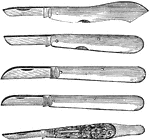
Budding Knives
Some blades, such as the first two, are made with a rounded point to cut the bark without the knife…
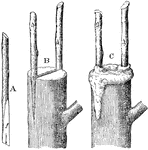
Cleft Grafting
This illustration shows a method of cleft grafting. Part A shows the scion, B, the scions inserted in…
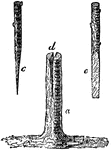
Cleft-Grafting
"Cleft-grafting is another method in common use. The stock a is cleft down from the horizontal cut d,…

Cutting Plant Sections
"Illustrating how the section knife or razor is drawn across the strop." -Stevens, 1916

Root-Grafting of Dahlia
Grafting is a method of asexual plant propagation widely used in agriculture and horticulture where…

Flute-Budding
In flute budding a cylinder of bark is removed from the stock, and a piece of twig in a similar size…

Mode of Supporting the Graft
Grafting is placing two cut surfaces of one or different plants under conditions which cause them to…
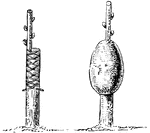
Mode of Tying and Claying Graft
Grafting is placing two cut surfaces of one or different plants under conditions which cause them to…
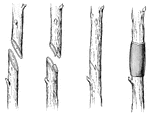
Grafting
(a) the two branches to be joined; (b) a tounge cut in each; (c) how fitted together; (d) method of…

Grafting
Image showing how crown grafting is done. Grafting is marrying two plants so the sap's circulation between…

Grafting
"Grafting. At the left scion and stock are shown ready to be united; at the right they are joined and…

Grafting by Approach
Grafting is placing two cut surfaces of one or different plants under conditions which cause them to…

Approach Grafting
Inarching, also known as approach grafting, is used to join two plants that are otherwise very difficult…

Cleft Grafting
(a) cut several scions, each having a few buds, making the ends in a wedge shape; (b) insert scions…

Cleft Grafting
Grafting is placing two cut surfaces of one or different plants under conditions which cause them to…
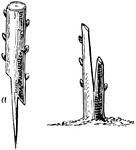
Cleft Grafting
Grafting is placing two cut surfaces of one or different plants under conditions which cause them to…
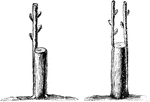
Crown or Rind Grafting
Grafting is placing two cut surfaces of one or different plants under conditions which cause them to…

Double Grafting
Grafting is placing two cut surfaces of one or different plants under conditions which cause them to…
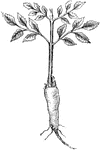
Root Grafting
Grafting is placing two cut surfaces of one or different plants under conditions which cause them to…
Root Grafting
A cion (smooth, one year old lenth of twig cut into a sex inch length) and root pictured, about to be…

Saddle Grafting
Grafting is placing two cut surfaces of one or different plants under conditions which cause them to…
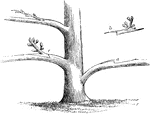
Side Grafting
Grafting is placing two cut surfaces of one or different plants under conditions which cause them to…
Wedge Grafting
Grafting is placing two cut surfaces of one or different plants under conditions which cause them to…
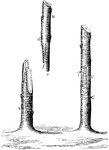
Whip or Tongue Grafting
Grafting is placing two cut surfaces of one or different plants under conditions which cause them to…

Mulberry Grafting
Illustrated is a method of mulberry grafting: (a) the cion, (b) matrix to receive the cion, (c) the…

Ring Budding
A ring of bark is removed in ring budding and replaced with a piece from a larger branch. When replaced…
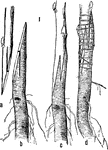
Root Grafting
"Root grafting in its different stages. a, Scion cut for insertion; b, stock prepared to receive the…
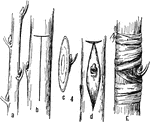
Budding Grafting
"Budding. a, Budstick; b, T-shaped cut in bark of stock; c, bud ready for insertion; d, stock with bud…

Cleft Grafting
"Cleft grafting (Herbaceous). a, Scion ready for insertion; b, stock; c, stock and scion unted; d, the…

Root-Grafting
"Fahlias and paeonies may be grafted by inserting young shoots into the neck of one of the fleshy roots…

Root-Grafting
"In the case of large woody plants thus worked the grafted roots, after the operation is completed,…

Rose Budding
This is a tall briar with three shoots. A shows the shoot slit for the bud. B shows the bud inserted.…
Branch showing Rose Buds
This is a branch showing buds. The lower buds are the most suitable because they are in firmer wood.…
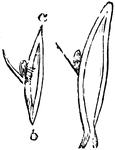
Bud Taken from Rose Budding
The left figure shows a bud taken from a budding branch. The right figure shows wood removed from the…

Shoots of Briar
Shoots of briar must be cut back before the rose buds once the buds are safely established.

Shield Budding
In shield-budding the bark should first have two incisions, a length wise incision one inch long, and…
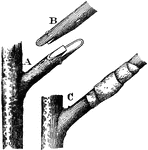
Tongue Grafting
To graft two plants together using the tongue or whip grafting approach, you must first make a sloping…
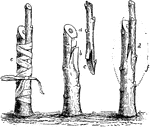
Whip-Grafting
"Whip-grafting or tongue-grafting is the most usual mode of performing the operation. The stock is headed…

Root-Grafting of Woody Plant
Grafting is a method of asexual plant propagation widely used in agriculture and horticulture where…






